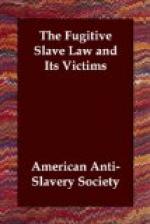surpassed the wildest thought of fiction.
The slaves, on reaching the marshal’s office, seated themselves around the stove with dejected countenances, and preserved a moody silence, answering all questions propounded to them in monosyllables, or refusing to answer at all. Simon is apparently about fifty-five years of age, and Mary about fifty. The son of Mr. Marshall, who is here, in order, if possible, to recover the property of his father, says that they have always been faithful servants, and have frequently been on this side of the river. Simon, Jr., is a young man, about twenty-two years old, of a very lithe and active form, and rather a mild and pleasant countenance. Margaret is a dark mulatto, twenty-three years of age; her countenance is far from being vicious, and her senses, yesterday, appeared partially stultified from the exciting trials she had endured. After remaining about two hours at the marshal’s office, Commissioner Pendery announced that the slaves would be removed to the custody of the United States Marshal until nine o’clock Tuesday morning, when the case would come up for examination.
The slaves were then taken down stairs to the street-door, when a wild and exciting scene presented itself; the sidewalks and the middle of the street were thronged with people, and a couple of coaches were at the door in order to convey the captives to the station-house. The slaves were guarded by a strong posse of officers, and as they made their appearance on the street, it was evident that there was a strong sympathy in their favor. When they were led to the carriage-doors, there were loud cries of “Drive on!” “Don’t take them!” The coachmen, either from alarm or from a sympathetic feeling, put the whip to their horses, and drove rapidly off, leaving the officers with their fugitives on the sidewalk. They started on foot with their charge to the Hammond Street station-house, where they secured their prisoners for the night.
The slaves claimed that
they had been on this side of the
river frequently, by
consent of their masters.
About three o’clock application was made to Judge Burgoyne for a writ of habeas corpus, to bring the slaves before him. This was put in the hands of Deputy Sheriff Buckingham to serve, who, accompanied by several assistants, proceeded to Hammond Street station-house, where the slaves were lodged. Mr. Bennett, Deputy United States Marshal, was unwilling to give them up, and a long time was spent parleying between the marshal and the sheriff’s officers. The sheriff being determined that the writ should be executed, Mr. Bennett went out to take counsel with his friends. Finally, through the advice of Mayor Faran, Mr. Bennett agreed to lodge the slaves in the jail, ready to be taken out at the order of Judge Burgoyne. Mr. Buckingham obtained the complete control of the slaves.
On the morning of the 29th, Sheriff




